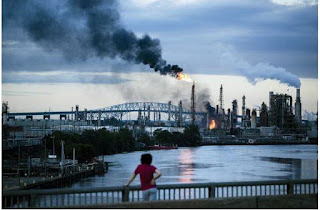I'm supposed to stay in the middle on the big issues we face every day.
Aside from our editorial and op-ed pages.
And this blog, of course.
So I can tell you that the very first thing that went through my mind when I heard about that massive explosion and fireball that erupted at the Philadelphia Energy Solutions refinery in Southwest Philly early Friday was this:
Mariner East Pipeline.
I know, that's not really fair.
They're not the same thing. The PES refinery, the largest on the East Coast, creates a variety of petroleum products including gasoline, diesel fuel and home heating oil. Then there was word that the initial fire may have started in a vat of either ethane or propane.
Maybe it was that reference that set off alarm bells for me.
Mariner East is moving hundreds of thousands of barrels of ethane, propane and butane from the state's Marcellus Shale region to a facility in Marcus Hook, where it will be stored and then shipped, the large bulk of it to overseas markets in the manufacture of plastics.
But that horrific video of the initial blast at the refinery was exactly the type of scenario that the many critics of Mariner East have been complaining about for years.
Words such as 'Armageddon' and 'catastrophe' were being used.
The fire burned for more than 24 hours, even after it was controlled.
Now the investigation will try to pinpoint what went wrong and what led to the explosion and fire.
The key factor in the refinery fire was a very toxic material called hydrofluoric acid that is used in the alkylation unit, where crude oil is converted into fuels. The hydrofluoric acid is used as a catalyst.
Some experts believe an explosion involving hydrogen fluoride could send a toxic cloud out over a 7-mile radius.
It is exactly that kind of scenario that has worried critics of the Mariner East project, specifically the fact that despite carrying these volatile elements at high pressure, it runs through densely populated neighborhoods.
They say a leak and explosion would envelop areas as much as a mile away.
Air readings around the refinery have consistently indicated there is no problem.
Environmental and neighborhood groups aren't that sure.
Today a small army of local and federal officials will investigate what happened. Those include the Bureau of Alcohol, Tobacco, Firearms and Explosives, the city health department, a fire hazamat unit and the U.S. Chemical Safety and Hazard Investigation Board.
They no doubt will eventually find the source - and the case - of the blast and fire.
Easing the concerns of residents who live near there - as well as those who live in the path of the Mariner East - likely will take a lot longer.

Comments